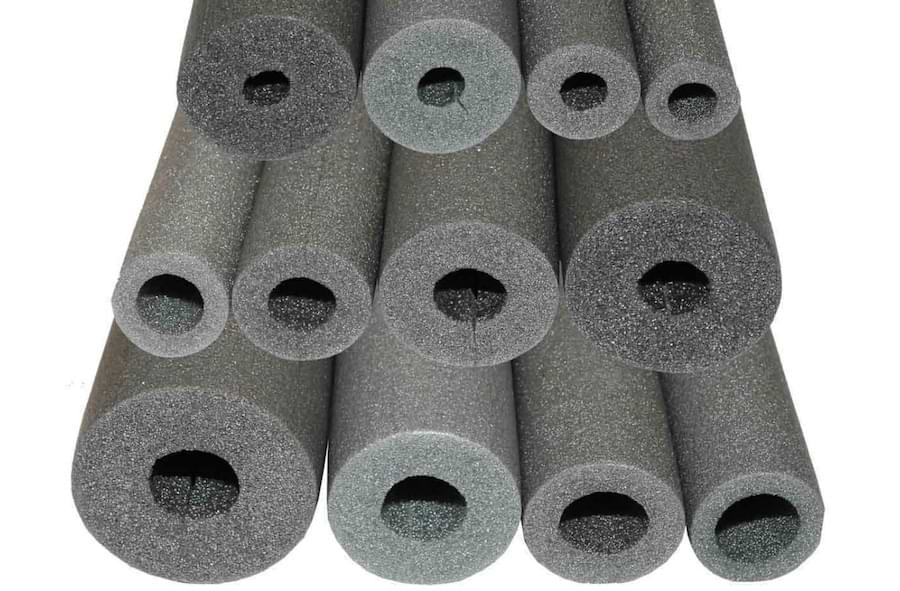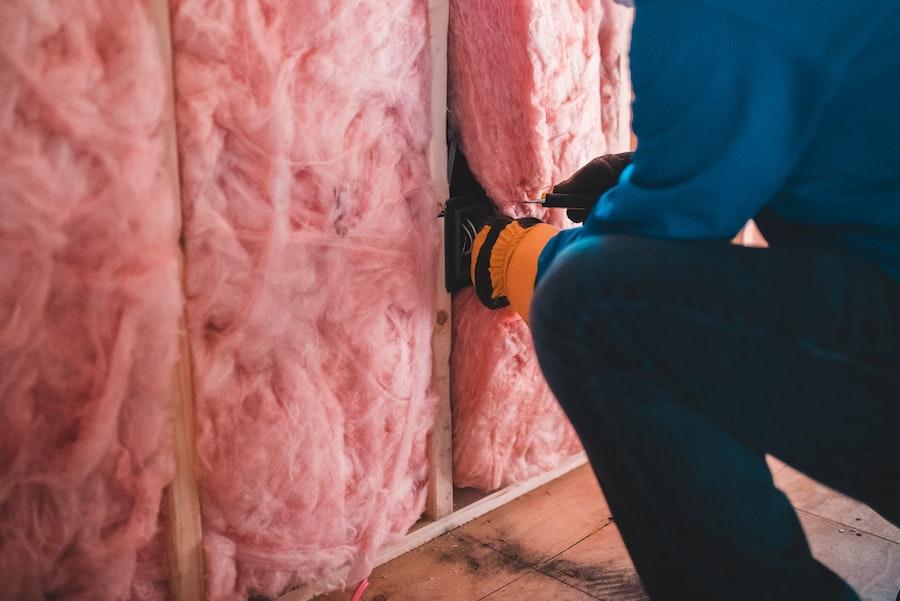Here are the main differences between foam vs fiberglass for pipe insulation. Let’s get into the detail, starting with a quick summary table.
| Property | Foam | Fiberglass |
| How it works | Traps heat and air. Spray foam is not air-permeable | Traps heat and air |
| Installation process | Cut from sheets and secured with wires or bands Slip the hinged sections into the pipe and use the adhesive tape | Formed or sprayed around piping and other forms |
| Spray foam needs professional installation | Can be installed without expert knowledge | |
| Longevity | Lesser | Higher |
| Other properties | Fire-resistant and sound barrier | Fire-resistant and sound barrier |
| Cost | High | Low |
| R-Value | High | Low to medium |
To understand more on the topic of foam, or if you’re looking for different foam types, then read my article on types of foam.
How foam pipe insulation works
How foam pipe insulation works might vary a little from one type to another.
In general, both foam and fiberglass pipe insulation works the same way. The extent to which they work and their effectiveness varies depending mainly on the material they are made from and their related properties.
Both foam and fiberglass pipe insulation trap air, which gives out an insulating effect. When hot air is trapped within the surface of the piping or system it makes it hard for the pipes to release heated air into the environment, i.e. heat loss is restricted. Essentially this is akin to pipe lagging.
This helps pipes maintain the temperature of the water, without losing heat.
Because of this, your water can be as much as 2-4 degrees higher than it would have been without the foam insulation around the pipes.
This in turn means that the time taken for your water to heat up is reduced, this also then means your heater runs for less time, thereby saving on your electricity bills on a number of levels.
During winter, pipes with standing water in them can freeze. Both foam and fiberglass insulation helps to prolong the time before pipes freeze and means they will only freeze at a lower temperature.
Both methods can prevent pipes from freezing
With the greater thickness and insulative properties, both foam and fiberglass can prevent pipes from freezing altogether.
They do this by maintaining the water temperature higher than the temperature outside to prevent freezing.
However, spray foam pipe insulation generally works much more effectively than foam pipe insulation. As spray foam is sprayed, it can expand 60 times above its original size.
This makes it possible for spray foam to offer a denser, thicker, and more sealed material around the pipes that is far less likely to let air pass through or escape.

Foam vs Fiberglass – Installation process
Both foam and fiberglass pipe insulation can be cut from material sheets and installed by forming it around the pipes.
These are usually secured with wires or bands. Before pipe insulation became commonplace, this method of installation was used.
However, these days, both foam and fiberglass pipe insulation comes with a hinged section.
So you can easily open them up and slide the insulation over the piping. Depending on the type of insulation you get, you can either secure these with wires, tie wraps or bands.
Some types of foam and fiberglass insulation come with adhesive tape. Make sure you’re releasing the adhesive tape only when the pipe is properly aligned with the insulation. Firm pressure is then required to make sure the adhesive strip is well attached to the pipe.
In general, the installation of both foam and fiber insulation doesn’t call for professionals. All you have to do is just follow basic instructions which is often supplied with the product.
However, if you’re using the spray foam type of insulation, then it requires specialist equipment and trained professionals.
Spray foam also requires specific techniques and methods that should be precisely followed for proper installation.
Most importantly, spray foam can be dangerous to handle by yourself, so always obtain the services of a professional.
Foam vs Fiberglass – Longevity
Overall longevity for foam or fiberglass depends on a number of factors, including the thickness you prefer for insulation, and conditions around the installation.
Fiberglass pipe insulation can last longer than foam insulation. This is mainly based on the fact that foam insulation can shrink easily under heat.
When foam pipe insulation shrinks, it leaves gaps between the pipelines, which can disturb its effective insulation mechanism, thereby requiring a replacement.
For general home insulation, fiberglass insulation can last for up to 100 years and foam insulation for up to 80 years.
Pipe insulation can be affected by humidity, moisture, and condensation over a long period of time, and, so generally, the longevity will be lesser than the longevity for other types of insulation. But still, in general, fiberglass pipe insulation will offer greater longevity than foam pipe insulations.

Foam vs Fiberglass – Other properties
Both foam and fiberglass offer other properties, some of which are intangible but still present, let’s go through those now.
Sound proofing
Both foam and fiberglass pipe insulation has great sound-barrier properties. Foam is often used for soundproofing, so noisy pipes can also benefit from this application.
Fire resistance
With fire-resistant properties, both foam and fiberglass pipe insulations are considered and tested to be noncombustible.
This means you don’t need to be concerned about any combustible surfaces around your piping lines or system catching fire. Memory foam also has similar properties.
To sum up these properties though. Overall, spray foam pipe insulation can provide better fire resistance and sound barrier properties than regular foam or fiber insulation – again because of its dense properties.
Foam vs Fiberglass – cost effectiveness
The cost-effectiveness of pipe insulation comes with the R-value. R-value is an indication of how well the insulation can perform in preventing heat from escaping from the pipes.
A higher R-value indicates a higher performance and insulation capacity.
When the R-value is high, it means the need to run the heater or cooler for longer is reduced. Plus, the risk of the pipes freezing is also reduced. Thereby increasing cost-effectiveness.
It’s also generally accepted that this cost-effectiveness also depends on the thickness of the insulation alongside the R-value.
Generally, foam pipe insulation has an R-value of 2 per inch, but heavy-duty foam pipe insulation has an R-value of 4 per inch.
- Self-sealing types of foam insulation have an R-value ranging from 2-3 per inch
- Open-cell spray and closed cell spray foam have about R-3.7 and R-6.5 value per inch.
- Fiberglass pipe insulation has an R-value of 2.9 and 3.8 per inch.
- Fiberglass batt insulation has a higher R-value of 3.7-4.3 per inch.
So when it comes to cost-effectiveness, spray foam insulation stands out as the clear winner because of its higher R-value.
However, when you factor in the cost of purchase, then the fiberglass insulation has a reasonable price over foam insulation.
So in this case fiberglass insulation is a more affordable option over foam insulation, despite being lower performing. So spray foam is usually reserved for applications in which you want greater insulation qualities.
Selecting the right foam insulation
Pipe insulation is made of different materials and is able to insulate to different degrees.
Some are more suited for applications involving hot water. Others include a vapor barrier required for dealing with condensation along a cold-water pipe.
The main options are:
- Conventional foam insulation: With a slit down it’s length to make it easy to fit around piping. When fitted, tape and use plastic ties to seal it closed to maintain its insulating properties.
- Self-sealing foam insulation: Similar to conventional pipe insulation, but with a self-sealing features which is an adhesive strip along its open slit. Remove the tape cover, and press the adhesive strips together.
- Spray foam insulation: Usually installed by professionals who are equipped with spray triggers and pressurized containers of spray foam. Spray foam pipe insulation is ideal in difficult and small spaces, often between the water pipes and exterior walls. Sometimes available in spray cans for smaller applications by non-professionals.
- Fiberglass pipe covers: Usually hinged, and paper-coated. Rigid fiberglass insulation is commonly used where pipe temperatures are generally higher. Fiberglass is well known for its heat resistance.
Foam vs Fiberglass – Conclusion
So in conclusion, foam spray is better suited for applications where you need a higher R-value and lower heat loss. But for this, it is more expensive to install.
Foam piping is the cheaper option and is ideal for general home applications, where only moderate insulation is required, or where you simply need to prevent pipes from freezing. Foam is also easier to remove in the event that piping needs repair or additional work, so its a common material to use.
